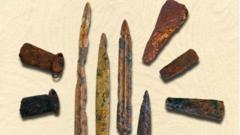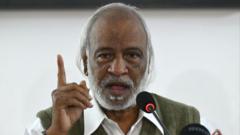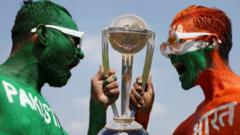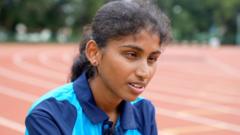The show "Waack Girls" highlights the story of six women navigating societal norms while embracing a dance style that champions self-expression and empowerment.
**Reviving Waacking: India's Dance Journey from the 1970s LGBTQ+ Scene to Modern Expressions**

**Reviving Waacking: India's Dance Journey from the 1970s LGBTQ+ Scene to Modern Expressions**
A new web series on Prime Video shines a light on the growing popularity of waacking, a dance form with deep-rooted ties to America's gay clubs.
The vibrant arms glide and whirl through the air, sparkling tassels dancing along with them. These captivating visuals introduce "Waack Girls," a recent web series on Amazon Prime Video that explores the journey of six women determined to form their city’s first all-female waacking crew. Directed by noted filmmaker Sooni Taraporevala, the series unfolds against the backdrop of a revitalized interest in waacking throughout various Indian cities, big and small.
"I was instantly drawn to the importance of self-expression within this dance style," Taraporevala shared, emphasizing her motivation for creating the series. Waacking’s presence is booming, with workshops and underground events rapidly spreading, inviting international dance legends to impart their wisdom. Archie Burnett, a 1970s New York club performer, recently visited India, contributing to the growing enthusiasm around this dynamic dance.
Dancers hope "Waack Girls" will elevate waacking's recognition, showcasing that there is a wealth of dance beyond classical interpretations and Bollywood. Born in the gay clubs of Los Angeles during the 1970s, waacking carries a historical significance tied to the LGBTQ+ liberation movement and the expressive beats of disco. This form was a response to the societal stigma surrounding homosexuality, with gay men using it as a means to assert themselves on the dance floor against a backdrop of discrimination and hatred.
Tejasvi Patil, a seasoned waacker from Mumbai, explained that the term "waacking" is derived from the onomatopoeic word "whack," resonant with the vivid action and sound effects found in comic books. The dance is characterized by dramatic poses, quick footwork, and striking arm movements, with dancers continuously embellishing the style with their individual flair.
The core of waacking’s ethos—the celebration of individuality and self-expression—makes it a profound tool for empowerment, particularly for the LGBTQ+ community in India. Ayushi Amrute, another veteran dancer, noted that many use the dance to explore their sexual identity, finding solace in the artistic freedom it provides. The community's commitment to maintaining a safe and welcoming space has made a significant impact, allowing personal discovery through movement.
In its early days in India, waacking was virtually unrecognized, requiring pioneering dancers to research its history and connect with foreign practitioners. However, the landscape has transformed in recent years, with a surge of interest among the youth eager to learn the dance. Patil, who also teaches, encourages her students to embrace the fundamental principles of self-expression rooted in waacking.
While India’s soundscape for waacking is still evolving, classic disco anthems from the likes of Donna Summer remain favorites, alongside popular Bollywood disco hits of the 1980s. For "Waack Girls," Taraporevala enlisted indie artists to create a distinctive soundtrack, pushing the boundaries of waacking’s sound in India.
"I believe the time is ripe for everyone to embrace their true selves," Patil affirms, confidently regarding waacking as a vibrant platform for this self-expression.
"I was instantly drawn to the importance of self-expression within this dance style," Taraporevala shared, emphasizing her motivation for creating the series. Waacking’s presence is booming, with workshops and underground events rapidly spreading, inviting international dance legends to impart their wisdom. Archie Burnett, a 1970s New York club performer, recently visited India, contributing to the growing enthusiasm around this dynamic dance.
Dancers hope "Waack Girls" will elevate waacking's recognition, showcasing that there is a wealth of dance beyond classical interpretations and Bollywood. Born in the gay clubs of Los Angeles during the 1970s, waacking carries a historical significance tied to the LGBTQ+ liberation movement and the expressive beats of disco. This form was a response to the societal stigma surrounding homosexuality, with gay men using it as a means to assert themselves on the dance floor against a backdrop of discrimination and hatred.
Tejasvi Patil, a seasoned waacker from Mumbai, explained that the term "waacking" is derived from the onomatopoeic word "whack," resonant with the vivid action and sound effects found in comic books. The dance is characterized by dramatic poses, quick footwork, and striking arm movements, with dancers continuously embellishing the style with their individual flair.
The core of waacking’s ethos—the celebration of individuality and self-expression—makes it a profound tool for empowerment, particularly for the LGBTQ+ community in India. Ayushi Amrute, another veteran dancer, noted that many use the dance to explore their sexual identity, finding solace in the artistic freedom it provides. The community's commitment to maintaining a safe and welcoming space has made a significant impact, allowing personal discovery through movement.
In its early days in India, waacking was virtually unrecognized, requiring pioneering dancers to research its history and connect with foreign practitioners. However, the landscape has transformed in recent years, with a surge of interest among the youth eager to learn the dance. Patil, who also teaches, encourages her students to embrace the fundamental principles of self-expression rooted in waacking.
While India’s soundscape for waacking is still evolving, classic disco anthems from the likes of Donna Summer remain favorites, alongside popular Bollywood disco hits of the 1980s. For "Waack Girls," Taraporevala enlisted indie artists to create a distinctive soundtrack, pushing the boundaries of waacking’s sound in India.
"I believe the time is ripe for everyone to embrace their true selves," Patil affirms, confidently regarding waacking as a vibrant platform for this self-expression.


















